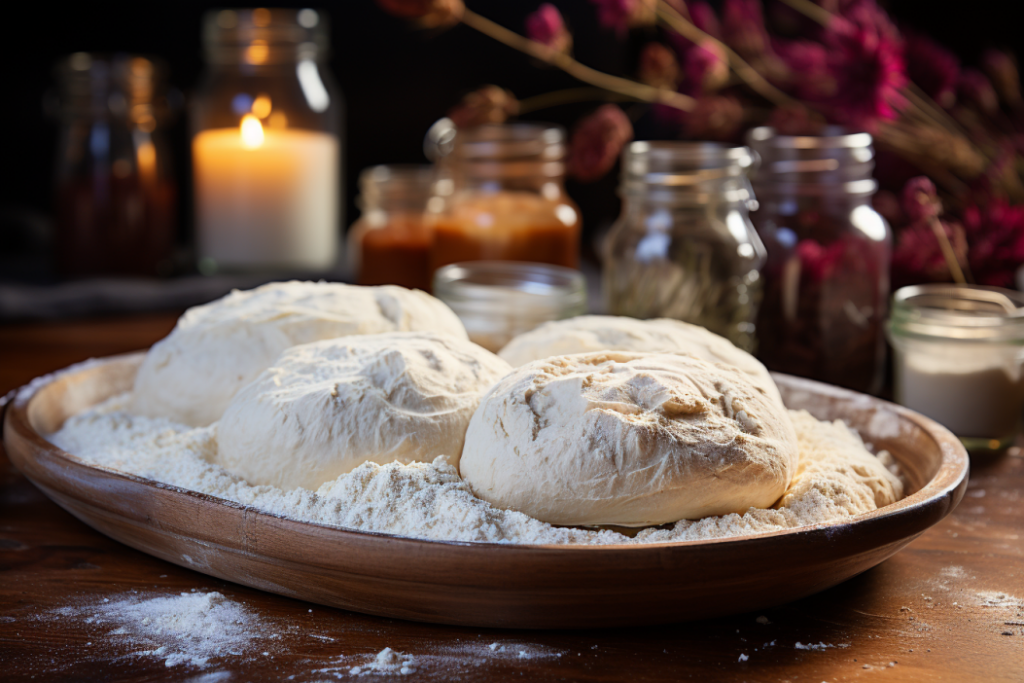Table of Contents
Discover the Secret Techniques for Perfecting Your Own Delicious Sourdough Bread at Home
If you’re a bread-lover, you’ve probably tried sourdough bread at some point and know how yummy it is. But did you know that it’s surprisingly easy to make it yourself at home? There’s something special about baking bread from scratch, and sourdough bread is no exception. Making it at home is not only cheaper, but it’s also healthier since you’re using natural yeast that’s wild fermented.
In this article, we’re going to show you the simple steps for making your own perfect homemade sourdough bread. You don’t need any special equipment. With just flour, water, salt, and a little bit of patience, you can create your own delicious loaf of sourdough bread. Plus, we’ll share some tips and tricks that will take your bread to the next level. Get ready to impress your family and friends with your bread-making skills!

Prepare the Dough
Making sourdough bread is all about patience and following a few critical steps correctly. The first, and perhaps most important step is preparing the dough. In this section, we’ll outline the essential aspects of preparing sourdough bread dough.
Ingredients
The first thing you’ll need is to gather all the ingredients you need. Here’s what you’ll need:
- 500g of bread flour or all-purpose flour
- 325g of water
- 10g of salt
- 100g of sourdough starter
Mixing the Dough
Mixing the dough is probably the most physical and labor-intensive part of the process. To get started, place the flour in a bowl and make a well in the middle. Pour the water into the well and add the starter. Mix well using your hand or a wooden spoon until the ingredients combine.
Resting the Dough
After mixing, the dough needs a little rest. You can choose to rest it at room temperature or place it in the fridge for an extended period. The resting time will depend on your preference and schedule. Most people choose to rest it for 30 minutes at room temperature, then place it in the fridge for an extended period.
Kneading the Dough
After the dough has rested, it’s time to knead it. Kneading is a crucial step in sourdough bread making as it helps the proteins in the dough to strengthen and develop gluten. Knead the dough by folding the edges towards the center and rotating it every time you fold it. After kneading, let the dough rest again to give the gluten time to develop.
Making sourdough bread requires some effort, but the results are worth it. Preparing the dough, ensuring it’s well-rested and kneading it correctly ensures you have a perfect dough, ready for the next stage in the bread-making process. Stay tuned for our next guide, where we talk about the next steps in our journey to making homemade sourdough bread!
Feed the Starter
The sourdough starter is a critical ingredient in making homemade sourdough bread. It’s what gives it that unique flavor and texture. In this guide, we’ll go through the essential aspects of feeding the starter.
What is a Sourdough Starter?
A sourdough starter is a mixture of flour and water that’s left to ferment. It’s the natural yeast in the air that ferments the mixture, creating a bubbly and gooey substance. The starter is what causes the bread dough to rise naturally during the bread-making process.
When to Feed the Starter
Feeding the starter is all about making sure that it’s active and healthy. You’ll know it’s time to feed your starter when it starts to look dull and inactive. Feed it right before you’re ready to make the bread.
How to Feed the Starter
Feeding the starter is pretty simple. You’ll need to remove some of the starter and feed it with fresh flour and water. Here’s how:
- Remove a portion of the starter, usually about 100g
- Add 100g of flour and 100g of water to the remaining starter
- Mix well and let it rest for at least 6 hours before using it
Tips for Maintaining a Healthy Starter
Maintaining a healthy starter is key to making great sourdough bread. Here are some quick tips on how to do it:
- Feed the starter regularly, at least once a week if you’re not using it
- Store the starter in a clean, airtight container in the fridge
- Use organic flour and filtered water when feeding the starter
In conclusion, feeding the starter is a simple but important step in making homemade sourdough bread. It’s what gives the bread its unique flavor and texture. Keep your starter healthy and active, and you’ll be sure to have great-tasting bread every time. Stay tuned for our next guide, where we talk about the next steps in our journey to making homemade sourdough bread!
Mix the Dough
Mixing the sourdough bread dough is one of the essential steps in making homemade sourdough bread. In this guide, we’ll discuss the essential aspects of mixing the dough and how to achieve the best results.
Ingredients
Before you start mixing the dough, gather the ingredients you’ll need:
- 500g flour (bread or all-purpose flour)
- 325g water
- 10g salt
- 100g sourdough starter
Steps to Mix the Dough
Now that you have all the ingredients ready, here are the steps to follow:
- In a large mixing bowl, sift in the flour and add salt. Mix the two ingredients well.
- Add the sourdough starter and water to the large mixing bowl. Mix everything together until it’s thoroughly combined.
- Let the dough rest for 30 minutes. This will make it easier to knead the dough later on.
- Knead the dough in the mixing bowl by folding the edges towards the center and rotating it every time you fold it. This step helps to develop gluten in the dough.
- Rest the dough for another 30 minutes before shaping or transferring it to a proofing basket.
Tips for Mixing the Dough
Here are some tips for mixing the dough:
- Use room-temperature water to make mixing easier.
- Overworking the dough can cause it to become dense and tough, so be careful not to overdo it.
- Handle the dough gently and avoid punching or pressing it too hard.
- Resting the dough between mixing and kneading gives the gluten time to develop. This makes the dough easier to roll out and shape.
Mixing the sourdough bread dough is a crucial step in the process, and attention to detail helps achieve the best results. Mixing the dough according to these steps and tips creates a great foundation for making homemade sourdough bread. Stay tuned for our next guide, where we talk about the next steps in making homemade sourdough bread!
Bulk Fermentation
Bulk fermentation is an essential step in making homemade sourdough bread. It’s the resting period after mixing the dough when the yeast is allowed to ferment, and the dough rises. In this guide, we’ll discuss the essential aspects of bulk fermentation and how to achieve the best results.
What is Bulk Fermentation?
Bulk fermentation is the stage of bread-making when the dough is left to rise after mixing. During this resting period, the yeast in the sourdough starter feeds on the flour, releasing carbon dioxide and other gases. This process causes the dough to rise and develop a rich, complex flavor.
How Long Should You Bulk Ferment Your Dough?
Bulk fermentation typically lasts between 4 and 12 hours, depending on the temperature of the environment. The dough should roughly double in size to know when it’s ready. The longer the fermentation, the more complex the flavor of the bread.
Tips for Bulk Fermenting Your Dough
Here are some essential tips for bulk fermentation:
- The ideal temperature for fermentation is between 68-75°F (20-24°C). Be mindful of this to ensure a consistent rise.
- Cover the bowl with a kitchen towel or cling film to keep the moisture in and prevent the top of the dough from drying out.
- Avoid jostling or cumbersome your dough during the fermentation process, which could cause the gas to escape.
- Test if your dough is ready for shaping by pressing a lightly floured finger gently in the center of the dough. If it springs back slowly, it’s ready to move to the next stage.
Bulk fermentation is a crucial step in making homemade sourdough bread. Allowing the dough to rest and rise after mixing is essential to creating the perfect texture and flavor. Follow the tips outlined above to achieve the best results. Stay tuned for our next guide, where we talk about the next steps in our journey to making homemade sourdough bread!
Shape the Loaf
Shaping the loaf is where the bread starts to take its final shape, and the flavors begin to develop. It’s essential to get this step right because it affects the final presentation and ensures the loaf comes out perfect. Here’s a quick guide on the essential aspects of shaping the loaf for homemade sourdough bread.
What is Shaping the Loaf?
Shaping the loaf is the process of transforming the bulk-fermented dough into the final desired shape. Many shapes can be given to the dough, depending on personal preference and the type of bread you want to make. Some common shapes are boules, batards, and baguettes.
How to Shape the Loaf
Shaping the loaf is a simple process that involves the following steps:
- Flour your surface to prevent the dough from sticking.
- Gently tip the dough out of the bowl and onto the floured surface.
- Using a bench scraper, divide the dough in two or more pieces, depending on the size and type of bread you want to make.
- Take each dough piece and shape it into your desired loaf shape.
- Place the shaped loaves in a proofing basket and cover with a kitchen towel.
- Let them rise again before baking.
Tips for Shaping the Loaf
Here are some tips for shaping the loaf:
- Be gentle when shaping the dough, so you don’t deflate all the air.
- Use a bench scraper, so the dough doesn’t stick to your hands.
- Dust your proofing basket with flour to prevent the dough from sticking.
- Use a kitchen towel to cover your dough to prevent it from drying out.
Conclusion
Shaping the loaf is essential to getting the perfect homemade sourdough bread. Ensuring the dough is not too deflated and maintaining the shape is key. Follow the tips outlined above to achieve the best results. Stay tuned for our next guide, where we talk about the final stages to making homemade sourdough bread!
Bake the Bread
We’ve made it to the final stage of our journey to make homemade sourdough bread – baking the bread. In this guide, we’ll be covering the essential aspects of baking the bread and how to get the best results.
Preheat Your Oven
The first step in baking the bread is to preheat your oven. Turn the oven to 450°F (230°C) and let it preheat for at least 45 minutes. Preheating is essential to creating a hot environment that allows your bread to rise and has the beautiful crust.
Scoring the Dough
Scoring the dough is the act of cutting the top of the bread before putting it in the oven. This helps to release steam and control the expansion of the bread in the oven. Use a sharp blade, and slice the dough with a quick and precise motion.
Baking the Bread
Place the bread onto a baking tray/paper and put it directly into the preheated oven. Spray the oven walls with water to create steam and shut the door quickly to trap the steam. Bake for about 35-45 minutes until the crust is golden brown.
Checking for Doneness
The best way to tell if your bread is done is by checking the temperature inside its core. The ideal temperature is about 200-210°F (93-99°C). A nice crust sound when tapping the base tells also it’s ready to go if the thermometer is not available.
Cooling the Bread
Allow the bread to cool before cutting it. Cooling the bread gives it time to set properly and for the internal temperature to drop. Place the bread on a wire rack to cool and enjoy it once it’s no longer too hot.
Baking the bread is the final step in making homemade sourdough bread. With the right oven temperature, scoring, and baking time, this step ensures that you get the perfect crust while maintaining the bread’s flavors. Follow the tips outlined above to achieve the best results and enjoy your delicious homemade sourdough bread!
Cool and Enjoy!
The final step in making homemade sourdough bread is to cool it and enjoy it! In this guide, we’ll walk you through the essential aspects of cooling and preserving your sourdough bread to keep it fresh.
Cooling the Bread
After baking, allow the bread to cool completely before slicing it. This allows the bread to settle properly and ensures you have beautiful slices when you’re ready to eat it. Place the bread on a wire rack and cover it with a towel. It will take about an hour for the bread to completely cool down.
Preserving Your Sourdough Bread
If you’ve made too much bread or are not planning on eating it right away, you can preserve it to keep it fresh for a longer time.
Here are some ways to keep your sourdough bread fresh:
- Wrap it in plastic wrap or airtight container
- Freeze it and thaw when needed
- Slice it and store sliced bread in the freezer – this makes it easy to toast when you want it
Ways to Enjoy Your Sourdough Bread
Once your bread is cooled, sliced, and stored away, it’s ready to eat! Here are some simple ways to enjoy your homemade sourdough bread:
- Make a sandwich with your favorite fillings
- Toast it and serve it with butter and jam
- Turn it into homemade croutons for salads and soups
- Serve it with olive oil, vinegar, and freshly ground black pepper
Sourdough bread is delicious and easy to make from scratch at home. With the right techniques and attention to detail, you can enjoy freshly baked bread right from your own kitchen. Follow the tips outlined in this guide to cool and store your bread properly and enjoy it in many different ways. Happy baking and eating!
Conclusion
Making homemade sourdough bread can be a rewarding and enjoyable experience. It takes time and patience, but the end result is worth it. From preparing the dough, feeding the starter, mixing the dough to bulk fermentation, shaping and baking, and finally cooling and enjoying the bread in various ways, every step is crucial in creating a delicious sourdough loaf.
Sourdough is a natural bread, and each loaf is unique to the









